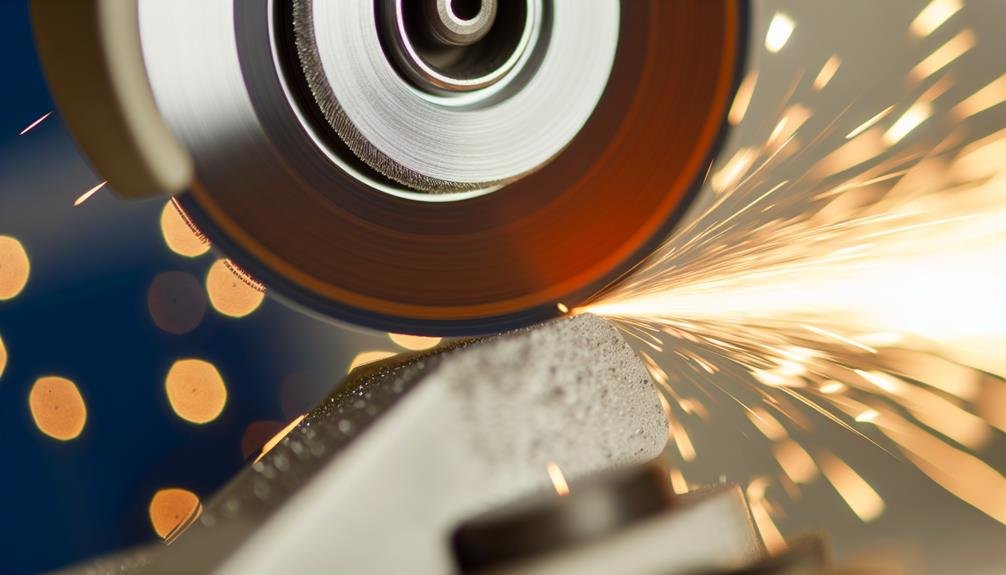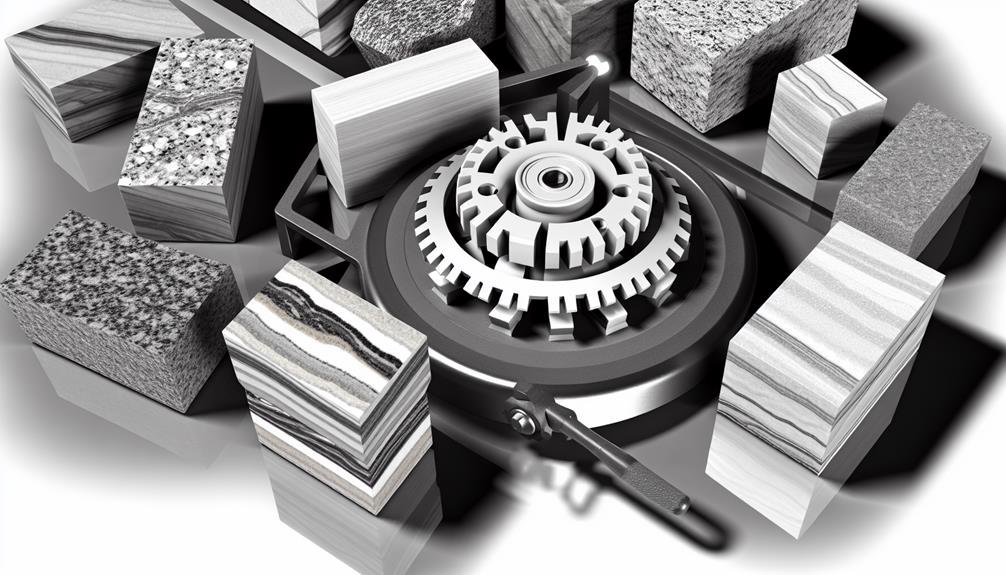In the realm of stone processing and precision machining, the role of a chamfering wheel is often underappreciated. The chamfering wheel, with its unique ability to create angular or beveled edges, provides the much-needed finishing touch to the stone edges, defining their aesthetic appeal and functional performance.
The application of this tool extends across various industries, from construction to furniture design, and even in the technology sector where it aids in the production of precisely engineered parts. While the concept may seem straightforward, the intricacies involved in choosing the right chamfering wheel and fully leveraging its potential are vast and complex, warranting a comprehensive exploration of the subject.

In the realm of stone processing, the chamfering wheel plays a pivotal role, meticulously grinding the edges of stone surfaces at a precise angle to create beveled edges, thereby enhancing the safety, durability, and visual appeal of the final product. It is an invaluable tool for precision cutting and stone shaping, delivering unparalleled control over the edge finishing process.
The chamfering wheel is responsible for bevel creation, a technique that involves grinding the edge of the stone at a specific angle, typically 45 degrees. This process removes sharp edges, promoting safety and increasing the overall durability of the stone product. The resulting beveled edge not only adds a professional finish but also elevates the aesthetic appeal, making it a preferred choice for countertops, tiles, and architectural elements.
Surface smoothing is another notable function of the chamfering wheel. It ensures a consistently smooth finish across the stone surface, eliminating any rough spots that might detract from the product's visual appeal or safety. With the chamfering wheel, professionals can confidently deliver stone products that meet the highest standards of quality and safety, adhering to the precise specifications demanded by today's discerning consumers.
The chamfering wheel offers notable benefits and effects, particularly in terms of efficiency, precision, and versatility.
This tool, respected for its high level of sharpness and long service life, can significantly streamline the process of edge refinement in a variety of materials.
As we proceed, we will discuss these benefits in greater detail, illuminating the value they provide to industries requiring precision edges.
With its robust construction and advanced technology, the chamfering wheel provides exceptional precision and efficiency, enhancing the quality of work while reducing labor time. When it comes to Precision Control, the chamfering wheel reigns supreme, providing uniform edges with minimal effort.
These attributes make the chamfering wheel an invaluable tool for any professional seeking control and perfection.
Beyond enhancing precision and boosting productivity, the chamfering wheel also boasts impressive sharpness and durability, key factors contributing to its long service life. The edge durability of this tool is a testament to meticulous engineering, ensuring efficient sharpening for extended periods.
To get the best out of your chamfering wheel, understanding chamfering techniques and optimal usage is crucial. This includes adopting correct angles and pressures during operation. Maintenance is equally important for preserving sharpness and durability. Regular checks for wear and tear, combined with appropriate cleaning procedures, will not only extend its service life but also maintain its performance. In the long run, this translates into cost savings and increased operational efficiency.
Embracing a wide range of applications, the chamfering wheel showcases its versatility in various industries, delivering superior results and enhanced operational efficiency. This wheel versatility stems from its adaptability to different materials and application requirements, making it a valuable tool for precision control and edge finishing.
The process of utilizing a chamfering wheel for stone involves a series of precision-driven steps designed to create smooth, angled edges. It begins with proper wheel maintenance, which is critical to ensure the longevity and performance of the chamfering tool. This includes routine cleaning, inspection for damage, and replacing worn-out parts.
Next, the user must apply specific chamfering techniques to achieve the desired edge profile. This may require adjusting the wheel's speed or angle and applying consistent pressure. Innovative chamfering methods, such as the use of computer-aided machinery, can enhance precision and control.
Safety measures are paramount throughout this process. Users should wear protective gear, adhere to proper handling procedures, and maintain a safe distance from the operating wheel.
Despite meticulous attention to these steps, occasional chamfering troubleshooting may be needed. This could involve addressing issues like uneven chamfering, excessive wheel wear, or vibrations during operation.
In the realm of chamfering tools, there are several distinct types of wheels used to achieve precision edges. The Resin-Bond Silicon Carbide Chamfering Wheel, Metal-Bond Diamond Chamfering Wheel, and Resin-Bond Diamond Chamfering Wheel are among the most prominent.
Each of these types possesses unique characteristics and applications which we will now examine.
Among the different types of chamfering wheels, the Resin-Bond Silicon Carbide Chamfering Wheel stands out for its smooth, sharp chamfering and its ability to maintain prolonged continual work times, particularly in the fine chamfering of ceramic tiles. These unique properties make it an indispensable tool for professionals seeking precision edges with a safety guarantee.
Resin-Bond Silicon Carbide Chamfering Wheel offers:
Why choose a Metal-Bond Diamond Chamfering Wheel? This particular type of chamfering wheel offers high working efficiency and excellent chamfering effects, especially for ceramic tiles post-polishing.
The Metal-Bond Diamond Chamfering Wheel, using diamond abrasives and metal bonding technology, provides precision cutting and exceptional edge finishing. This is due to the advanced abrasive technology used in its manufacturing.
Shifting focus to another significant type of chamfering wheel, the Resin-Bond Diamond Chamfering Wheel offers fine chamfering on ceramic tiles edges, ensuring safe transportation and usage. This wheel, with diamond abrasives, provides precision cutting unmatched by other abrasive tools.

Understanding the specifications of a chamfering wheel is critical for optimal performance and results.
Key specifications to consider include:
Each of these factors plays a significant role in the functionality, durability, and effectiveness of the chamfering wheel.
The chamfering wheel, primarily composed of stainless steel and diamond, is designed to ensure precision and durability in operations. The unique blend of these materials results in a tool highly capable of precision finishing, edge smoothing, surface shaping, and material removal.
To further understand the significance of its material composition, consider the following points:
In the realm of chamfering wheel specifications, grain sizes play a pivotal role, with options ranging from 60 to as high as 3000. The selected grain size directly influences the abrasive options, surface finish, and edge profile. A smaller grain size often facilitates finer finishes, while a larger grain size effectively expedites material removal.
The grain size also impacts the tool's longevity. A larger grain size can result in reduced tool life due to more aggressive material removal, which can cause the tool to wear out faster. Conversely, a smaller grain size tends to extend tool longevity, although it may reduce the speed of material removal. Therefore, selecting the appropriate grain size is crucial to balance between precision, efficiency, and tool life.
Drawing a parallel from the importance of grain sizes in chamfering wheel specifications, another significant aspect to consider is the bond method, particularly the choice between metal or resin bond.
Delving into the realm of chromatics, colour plays an integral role in the specifications of chamfering wheels, with variations like blue and black offering distinctive purposes and advantages. The colour variations signify the wheel's unique characteristics and functions, thereby assisting tool operators to choose the most suitable one for their specific tasks.
Blue chamfering wheels are primarily used for precision cutting and edge smoothing, offering a consistent and high-quality surface finishing. On the other hand, black chamfering wheels are designed for tool maintenance, ensuring durability and longevity. Therefore, understanding the colour specifications is crucial for optimal utilization of chamfering wheels.
Just as the colour of chamfering wheels holds significance, the thickness too plays a critical role in determining the specific applications and efficiency of these tools. The thickness of the chamfering wheel can influence edge precision, surface finish, the grinding process, material removal, and edge protection.
Choosing the appropriate thickness is therefore essential for control over these parameters.
In considering the application of chamfering wheels, it's essential to note that they are highly effective in dry grinding and heavy-duty work scenarios. These wheels are engineered for precision cutting, edge finishing, and surface preparation. They are known for their tool longevity and efficiency in material removal.
The table below provides a succinct overview:
| Application | Benefit | Keyword |
|---|---|---|
| Dry Grinding | High Efficiency | Precision Cutting |
| Heavy-Duty Work | Strong Durability | Tool Longevity |
| Surface Preparation | Smooth Finish | Edge Finishing |
| Material Removal | Quick Execution | Surface Preparation |
Understanding these usage scenarios gives you a sense of control over your work process, ensuring you select the right chamfering wheel for your specific needs, maximizing productivity and quality.
Several types of stones, including Apricena Stone, Limestone, Marble, Cement Marble, Trani Stone, and Travertine, are suitable for precision chamfering. Choosing the right stone type is crucial for the successful application of chamfering wheel, mainly for stone cutting, edge finishing, surface polishing, and precision shaping.
The selection depends on a few factors:
Understanding these factors gives you control over the final output. The right combination of stone type and chamfering wheel ensures an optimal chamfering process, leading to a precision edge finish.
Safety precautions include appropriate wheel selection, usage of protective equipment, proper operator training, organized workspace setup, and established emergency protocols. These measures ensure control and safety during operation.
The lifespan of a wheel is dependent on usage, but regular maintenance is crucial. Replacement indicators include reduced efficiency and performance. Adherence to maintenance basics ensures optimal usage and extends the wheel's operational life.
Potential risks associated with wheel use include compromised wheel durability, increased equipment cost, stringent training requirements, work efficiency reduction, and issues with material compatibility. Each can negatively affect operational control and overall project outcomes.
Just like how a key fits certain locks, chamfering wheels aren't universally compatible with all stones. Stone compatibility depends on chamfering techniques, wheel materials, advanced applications, and specific chamfering wheel brands.
Yes, there are sustainable alternatives to traditional chamfering wheels. These include wheels made from biodegradable materials and recycled chamfering wheels, both of which contribute to green manufacturing and carbon footprint reduction through sustainable sourcing.
In conclusion, the chamfering wheel is a revolutionary tool in stone processing, offering an array of benefits such as precision, efficiency, and versatility. It is akin to a master sculptor, meticulously carving out flawless edges and corners.
Different types of chamfering wheels cater to various stone materials, each having unique specifications. Understanding and utilizing this tool can significantly elevate the quality and craftsmanship of stone processing.
GINGONG in China offers high-quality diamond polishing and edge grinding tools alongside ceramic machinery accessories. Our integrated solutions cater to individual needs, ensuring optimal performance and efficiency. We lead the industry in ceramics polishing, emphasizing effectiveness, cost control, and environmental sustainability. With "Sanmo" machines and meticulous attention to detail, GINGONG delivers top-notch abrasive products, setting the standard for excellence.
